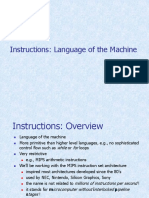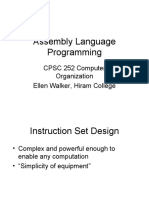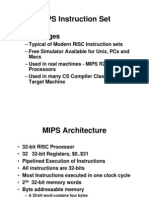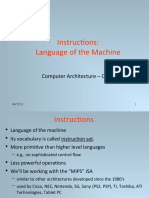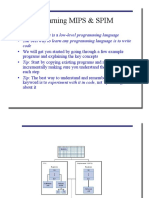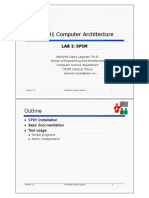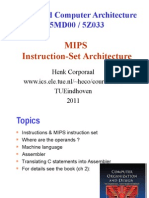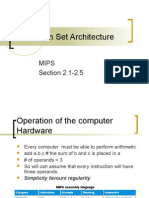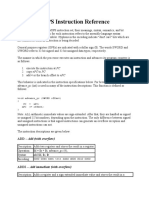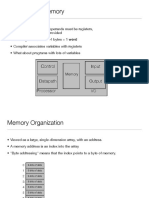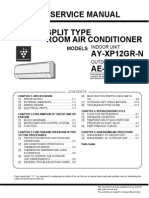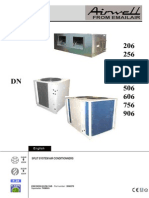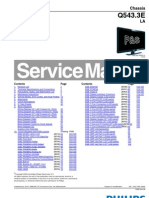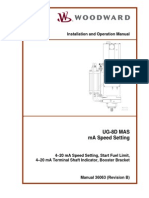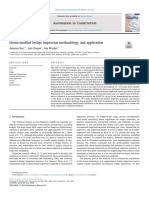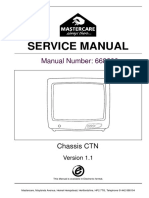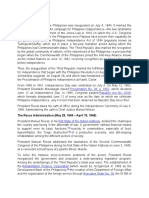11/26/2015
MIPS Quick Tutorial
MIPS Architecture and Assembly Language Overview
Adapted from: http://edge.mcs.dre.g.el.edu/GICL/people/sevy/architecture/MIPSRef(SPIM).html
[Register Description] [I/O Description]
Data Types and Literals
Data types:
Instructions are all 32 bits
byte(8 bits), halfword (2 bytes), word (4 bytes)
a character requires 1 byte of storage
an integer requires 1 word (4 bytes) of storage
Literals:
numbers entered as is. e.g. 4
characters enclosed in single quotes. e.g. 'b'
strings enclosed in double quotes. e.g. "A string"
Registers
32 general-purpose registers
register preceded by $ in assembly language instruction
two formats for addressing:
using register number e.g. $0 through $31
using equivalent names e.g. $t1, $sp
special registers Lo and Hi used to store result of multiplication and division
not directly addressable; contents accessed with special instruction mfhi ("move from Hi") and mflo ("move from Lo")
stack grows from high memory to low memory
This is from Figure 9.9 in the Goodman&Miller text
Register
Number
Alternative
Name
zero
the value 0
(assembler temporary) reserved by the assembler
Description
$at
2-3
$v0 - $v1
(values) from expression evaluation and function results
4-7
$a0 - $a3
(arguments) First four parameters for subroutine.
Not preserved across procedure calls
8-15
$t0 - $t7
(temporaries) Caller saved if needed. Subroutines can use w/out saving.
Not preserved across procedure calls
16-23
$s0 - $s7
(saved values) - Callee saved.
A subroutine using one of these must save original and restore it before exiting.
Preserved across procedure calls
(temporaries) Caller saved if needed. Subroutines can use w/out saving.
24-25
$t8 - $t9
26-27
$k0 - $k1
28
$gp
global pointer.
Points to the middle of the 64K block of memory in the static data segment.
29
$sp
stack pointer
Points to last location on the stack.
30
$s8/$fp
saved value / frame pointer
Preserved across procedure calls
31
$ra
These are in addition to $t0 - $t7 above.
Not preserved across procedure calls.
reserved for use by the interrupt/trap handler
return address
See also Britton section 1.9, Sweetman section 2.21, Larus Appendix section A.6
Program Structure
just plain text file with data declarations, program code (name of file should end in suffix .s to be used with SPIM simulator)
data declaration section followed by program code section
Data Declarations
placed in section of program identified with assembler directive .data
declares variable names used in program; storage allocated in main memory (RAM)
Code
http://logos.cs.uic.edu/366/notes/mips%20quick%20tutorial.htm
1/5
�11/26/2015
MIPS Quick Tutorial
placed in section of text identified with assembler directive .text
contains program code (instructions)
starting point for code e.g.ecution given label main:
ending point of main code should use exit system call (see below under System Calls)
Comments
anything following # on a line
# This stuff would be considered a comment
Template for a MIPS assembly language program:
# Comment giving name of program and description of function
# Template.s
# Bare-bones outline of MIPS assembly language program
.data
# variable declarations follow this line
# ...
.text
# instructions follow this line
main:
# indicates start of code (first instruction to execute)
# ...
# End of program, leave a blank line afterwards to make SPIM happy
Data Declarations
format for declarations:
name:
storage_type
value(s)
create storage for variable of specified type with given name and specified value
value(s) usually gives initial value(s); for storage type .space, gives number of spaces to be allocated
Note: labels always followed by colon ( : )
example
var1:
array1:
.word
.byte
3
# create a single integer variable with initial value 3
'a','b' # create a 2-element character array with elements initialized
# to a and b
.space 40
# allocate 40 consecutive bytes, with storage uninitialized
# could be used as a 40-element character array, or a
# 10-element integer array; a comment should indicate which!
array2:
Load / Store Instructions
RAM access only allowed with load and store instructions
all other instructions use register operands
load:
lw
register_destination, RAM_source
#copy word (4 bytes) at source RAM location to destination register.
lb
register_destination, RAM_source
#copy byte at source RAM location to low-order byte of destination register,
# and sign-e.g.tend to higher-order bytes
store word:
sw
register_source, RAM_destination
#store word in source register into RAM destination
sb
register_source, RAM_destination
#store byte (low-order) in source register into RAM destination
load immediate:
li
register_destination, value
#load immediate value into destination register
example:
.data
var1: .word
.text
__start:
lw
li
sw
done
23
# declare storage for var1; initial value is 23
$t0, var1
$t1, 5
$t1, var1
# load contents of RAM location into register $t0: $t0 = var1
# $t1 = 5 ("load immediate")
# store contents of register $t1 into RAM: var1 = $t1
http://logos.cs.uic.edu/366/notes/mips%20quick%20tutorial.htm
2/5
�11/26/2015
MIPS Quick Tutorial
Indirect and Based Addressing
Used only with load and store instructions
load address:
la
$t0, var1
copy RAM address of var1 (presumably a label defined in the program) into register $t0
indirect addressing:
lw
$t2, ($t0)
load word at RAM address contained in $t0 into $t2
sw
$t2, ($t0)
store word in register $t2 into RAM at address contained in $t0
based or indexed addressing:
lw
$t2, 4($t0)
load word at RAM address ($t0+4) into register $t2
"4" gives offset from address in register $t0
sw
$t2, -12($t0)
store word in register $t2 into RAM at address ($t0 - 12)
negative offsets are fine
Note: based addressing is especially useful for:
arrays; access elements as offset from base address
stacks; easy to access elements at offset from stack pointer or frame pointer
example
.data
.space 12
.text
la
$t0, array1
li
$t1, 5
sw $t1, ($t0)
li $t1, 13
sw $t1, 4($t0)
li $t1, -7
sw $t1, 8($t0)
done
array1:
__start:
# declare 12 bytes of storage to hold array of 3 integers
#
#
#
#
#
#
# load base address of array into register $t0
$t1 = 5 ("load immediate")
first array element set to 5; indirect addressing
$t1 = 13
second array element set to 13
$t1 = -7
third array element set to -7
Arithmetic Instructions
most use 3 operands
all operands are registers; no RAM or indirect addressing
operand size is word (4 bytes)
add
sub
addi
addu
subu
$t0,$t1,$t2
$t2,$t3,$t4
$t2,$t3, 5
$t1,$t6,$t7
$t1,$t6,$t7
#
#
#
#
#
$t0 = $t1 + $t2; add as signed (2's complement) integers
$t2 = $t3 $t4
$t2 = $t3 + 5; "add immediate" (no sub immediate)
$t1 = $t6 + $t7; add as unsigned integers
$t1 = $t6 + $t7; subtract as unsigned integers
mult
$t3,$t4
div
$t5,$t6
mfhi
mflo
$t0
$t1
#
#
#
#
#
#
#
multiply 32-bit quantities in $t3 and $t4, and store 64-bit
result in special registers Lo and Hi: (Hi,Lo) = $t3 * $t4
Lo = $t5 / $t6 (integer quotient)
Hi = $t5 mod $t6 (remainder)
move quantity in special register Hi to $t0: $t0 = Hi
move quantity in special register Lo to $t1: $t1 = Lo
used to get at result of product or quotient
move
$t2,$t3 # $t2 = $t3
Control Structures
Branches
comparison for conditional branches is built into instruction
b
beq
blt
target
# unconditional branch to program label target
$t0,$t1,target # branch to target if $t0 = $t1
$t0,$t1,target # branch to target if $t0 < $t1
http://logos.cs.uic.edu/366/notes/mips%20quick%20tutorial.htm
3/5
�11/26/2015
MIPS Quick Tutorial
ble
bgt
bge
bne
$t0,$t1,target
$t0,$t1,target
$t0,$t1,target
$t0,$t1,target
#
#
#
#
branch to target if
branch to target if
branch to target if
branch to target if
$t0 <= $t1
$t0 > $t1
$t0 >= $t1
$t0 <> $t1
j
jr
target # unconditional jump to program label target
$t3
# jump to address contained in $t3 ("jump register")
Jumps
Subroutine Calls
subroutine call: "jump and link" instruction
jal
sub_label
# "jump and link"
copy program counter (return address) to register $ra (return address register)
jump to program statement at sub_label
subroutine return: "jump register" instruction
jr
$ra
# "jump register"
jump to return address in $ra (stored by jal instruction)
Note: return address stored in register $ra; if subroutine will call other subroutines, or is recursive, return address should be copied from $ra onto stack to preserve
it, since jal always places return address in this register and hence will overwrite previous value
System Calls and I/O (SPIM Simulator)
used to read or print values or strings from input/output window, and indicate program end
use syscall operating system routine call
first supply appropriate values in registers $v0 and $a0-$a1
result value (if any) returned in register $v0
The following table lists the possible syscall services.
Service
Code
in $v0
Arguments
Results
print_int
$a0 = integer to be printed
print_float
$f12 = float to be printed
print_double
$f12 = double to be printed
print_string
$a0 = address of string in memory
read_int
integer returned in $v0
read_float
float returned in $v0
read_double
double returned in $v0
read_string
$a0 = memory address of string input buffer
$a1 = length of string buffer (n)
sbrk
$a0 = amount
exit
10
address in $v0
The print_string service expects the address to start a null-terminated character string. The directive .asciiz creates a null-terminated character string.
The read_int, read_float and read_double services read an entire line of input up to and including the newline character.
The read_string service has the same semantices as the UNIX library routine fgets.
It reads up to n-1 characters into a buffer and terminates the string with a null character.
If fewer than n-1 characters are in the current line, it reads up to and including the newline and terminates the string with a null character.
The sbrk service returns the address to a block of memory containing n additional bytes. This would be used for dynamic memory allocation.
The exit service stops a program from running.
e.g.
Print out integer value contained in register $t2
li
$v0, 1
move
$a0, $t2
syscall
e.g.
Read integer value, store in RAM location with label int_value (presumably declared in data section)
li
$v0, 5
syscall
sw
$v0, int_value
e.g.
# load appropriate system call code into register $v0;
# code for printing integer is 1
# move integer to be printed into $a0: $a0 = $t2
# call operating system to perform operation
# load appropriate system call code into register $v0;
# code for reading integer is 5
# call operating system to perform operation
# value read from keyboard returned in register $v0;
# store this in desired location
Print out string (useful for prompts)
string1
.data
.asciiz "Print this.\n"
main:
.text
li
$v0, 4
la
$a0, string1
# declaration for string variable,
# .asciiz directive makes string null terminated
# load appropriate system call code into register $v0;
# code for printing string is 4
# load address of string to be printed into $a0
http://logos.cs.uic.edu/366/notes/mips%20quick%20tutorial.htm
4/5
�11/26/2015
MIPS Quick Tutorial
syscall
# call operating system to perform print operation
e.g. To indicate end of program, use exit system call; thus last lines of program should be:
li
$v0, 10
syscall
# system call code for exit = 10
# call operating sys
http://logos.cs.uic.edu/366/notes/mips%20quick%20tutorial.htm
5/5









